How to Remove Coffee Stains from Teeth: A Comprehensive Guide
Coffee, the beloved morning beverage of millions worldwide, has a less-than-loving effect on our teeth. The dark, rich liquid that brings us so much joy can leave behind unsightly coffee stains, causing our teeth to lose their natural whiteness. As a result, many coffee lovers are left wondering how to remove coffee stains from their teeth.
We believe that you shouldn’t have to choose between your morning coffee and a bright, white smile. That’s why we’ve created this comprehensive guide to help you combat tooth discoloration caused by coffee. Whether you’re looking to prevent future stains or remove existing ones, you’ll find a wealth of knowledge and practical advice in the following sections.
1. Understanding Coffee Stains on Teeth
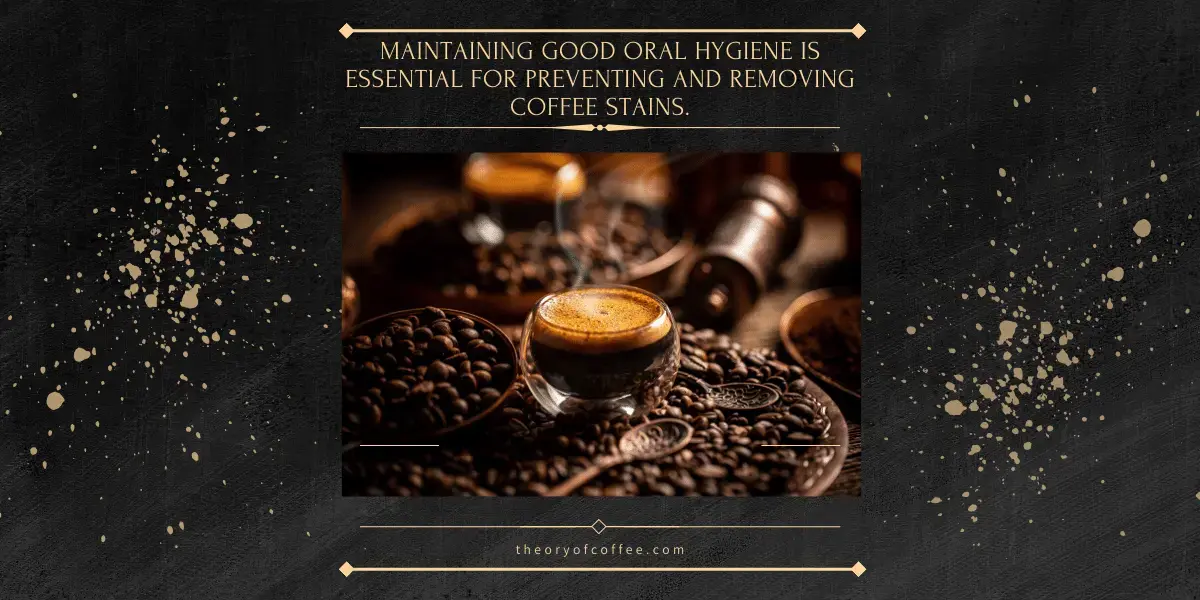
To effectively combat coffee stains, it’s essential to understand what causes them. The key culprits are compounds called tannins found in coffee. These tannins release colored products that stick to the surface of your teeth, causing them to appear yellow or brown over time. This staining is more likely when dental plaque is on the teeth.
Coffee is acidic and can erode tooth enamel, making it prone to staining. Frequent drinking of coffee can result in the accumulation of these blemishes, which can cause your teeth to lose their inherent brightness.
It’s also worth noting that coffee stains are not just a cosmetic issue. They can also contribute to dental problems such as tooth decay and gum disease, mainly if they are not addressed promptly. Therefore, maintaining good oral hygiene is essential for preventing and removing coffee stains.
2. Preventing Coffee Stains on Teeth
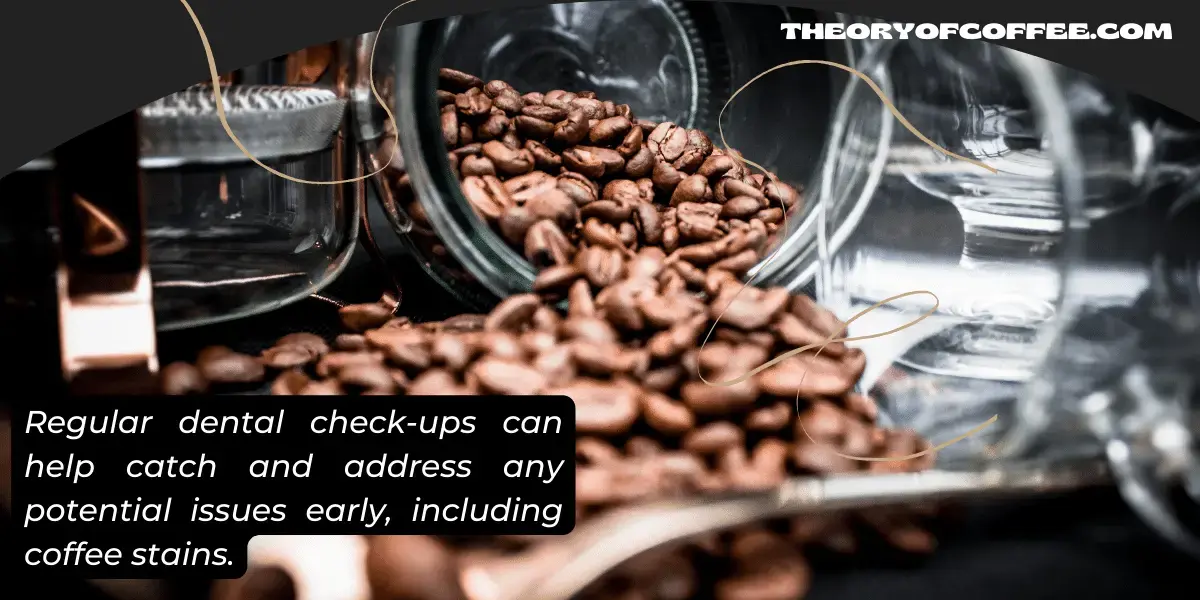
Prevention is always better than cure, and that’s undoubtedly true regarding coffee stains on teeth. Here are some preventative measures you can take:
- Regular Oral Hygiene: Brushing your teeth twice daily and flossing once daily to prevent plaque buildup and staining is recommended. Consider using a whitening toothpaste that contains baking soda or hydrogen peroxide to help combat surface stains.
- Dietary Choices: Certain foods and drinks can help prevent coffee stains. These include fruits and vegetables high in fiber, which can help clean your teeth, and dairy products, which can neutralize the acids in coffee that contribute to staining.
- Drink Water: Rinse your mouth with water after drinking coffee to help wash away the tannins that cause staining.
- Use a Straw: By minimizing direct contact with your teeth, you can enjoy your morning brew without worrying about potential staining or damage.
- Regular Dental Check-ups: Regular dental check-ups can detect and treat potential issues early, such as coffee stains.
Incorporating these practices into your routine allows you to enjoy your coffee while protecting your teeth from discoloration.
3. Over-the-Counter Solutions for Removing Coffee Stains
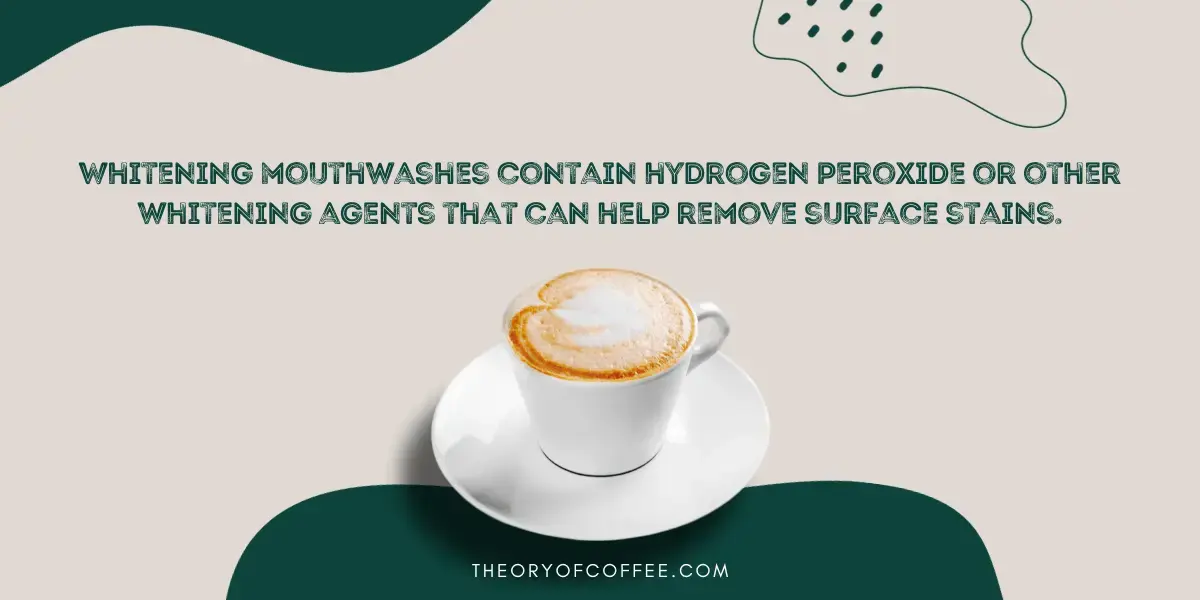
If coffee stains have already formed on your teeth, don’t worry. Several over-the-counter products can help you restore your teeth’s natural whiteness:
- Whitening Toothpaste: These toothpastes contain mild abrasives that can help remove surface stains. Look for a whitening toothpaste that is specifically formulated to target coffee stains.
- Whitening Strips: You can use these strips that are thin and flexible, and they come with a whitening gel that you apply to your teeth. They can effectively remove coffee stains, but using them as directed is essential to avoid damaging your teeth and gums.
- Whitening Mouthwash: Whitening mouthwashes contain hydrogen peroxide or other whitening agents that can help remove surface stains. Rinse your mouth with the mouthwash for the recommended amount of time to achieve the best results.
- Whitening Pens: Whitening pens are convenient and easy to use. They contain a whitening gel that you apply directly to the surface of your teeth. The gel is usually activated by sunlight or a special light in the pen.
These products can effectively remove coffee stains but differ from regular oral hygiene and dental check-ups. It’s also worth noting that they may not be suitable for everyone, particularly those with sensitive teeth. Hence, it’s always a good idea to consult a dental professional before starting a new whitening regimen.
4. Natural Remedies to Remove Coffee Stains
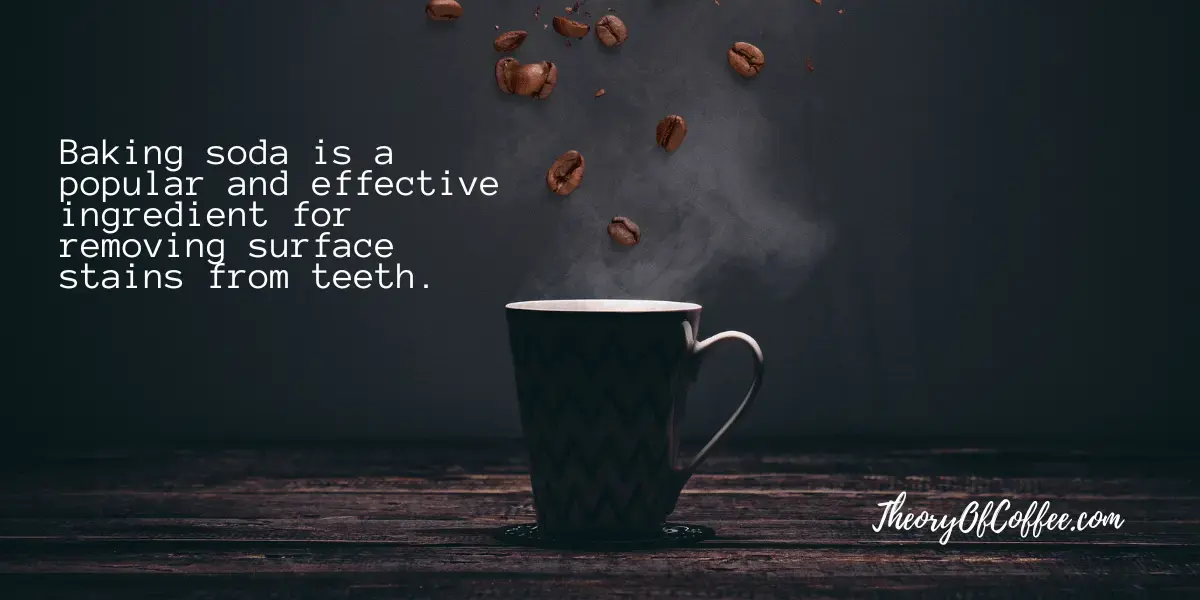
If you prefer to take a more natural approach to removing coffee stains from your teeth, there are several home remedies that you can try. While these remedies may not provide immediate results like professional whitening treatments, they can be effective over time and are often more affordable. Here are some natural remedies to consider:
4.1. Using Baking Soda
Baking soda is a popular and effective ingredient for removing surface stains from teeth. It works as a mild abrasive that helps scrub away coffee stains. To use baking soda for teeth whitening:
- Create a paste by mixing a small amount of baking soda with water until it forms a thick consistency.
- Apply the paste to your toothbrush and gently brush your teeth for two minutes.
- Rinse your mouth thoroughly with water.
- Repeat this process once or twice a week to avoid enamel erosion.
Note: Using baking soda in excess can be harmful to tooth enamel, so it is important to use it in moderation. If you experience tooth sensitivity or irritation, discontinue use and consult a dental professional.
4.2. Using Apple Cider Vinegar
One possible way to eliminate coffee stains from teeth is to use apple cider vinegar, a natural remedy. It contains acetic acid, which has natural bleaching properties. However, using apple cider vinegar cautiously is essential, as its acidity can potentially erode tooth enamel. Here’s how to use it:
- Mix one tablespoon of apple cider vinegar with a cup of warm water.
- Swish the solution around in your mouth for about 30 seconds.
- Spit out the mixture and rinse your mouth thoroughly with water.
- Brush your teeth with regular toothpaste to remove any remaining vinegar residue.
Remember to use apple cider vinegar in moderation and rinse your mouth thoroughly afterward to minimize potential damage to your teeth.
4.3. Using Hydrogen Peroxide
Hydrogen peroxide is a common ingredient in many whitening products due to its ability to remove stains. However, using hydrogen peroxide with caution is essential, as it can cause tooth sensitivity and gum irritation if misused. Here’s how to use it effectively:
- Mix equal parts of hydrogen peroxide and water in a small cup.
- Swish the mixture around your mouth for about one minute, being careful not to swallow it.
- Spit out the mixture and rinse your mouth thoroughly with plain water.
- Consider brushing your teeth with regular toothpaste afterward to remove residual hydrogen peroxide.
It’s crucial to dilute hydrogen peroxide with water to reduce its strength and minimize potential side effects. If you experience discomfort or sensitivity, discontinue use and consult a dental professional.
While these natural remedies can effectively remove coffee stains, it’s essential to remember that they may not provide immediate results. Consistency and patience are crucial when using natural remedies. Professional teeth whitening treatments may be better if you want faster and more dramatic results.
5. Professional Teeth Whitening for Coffee Stains
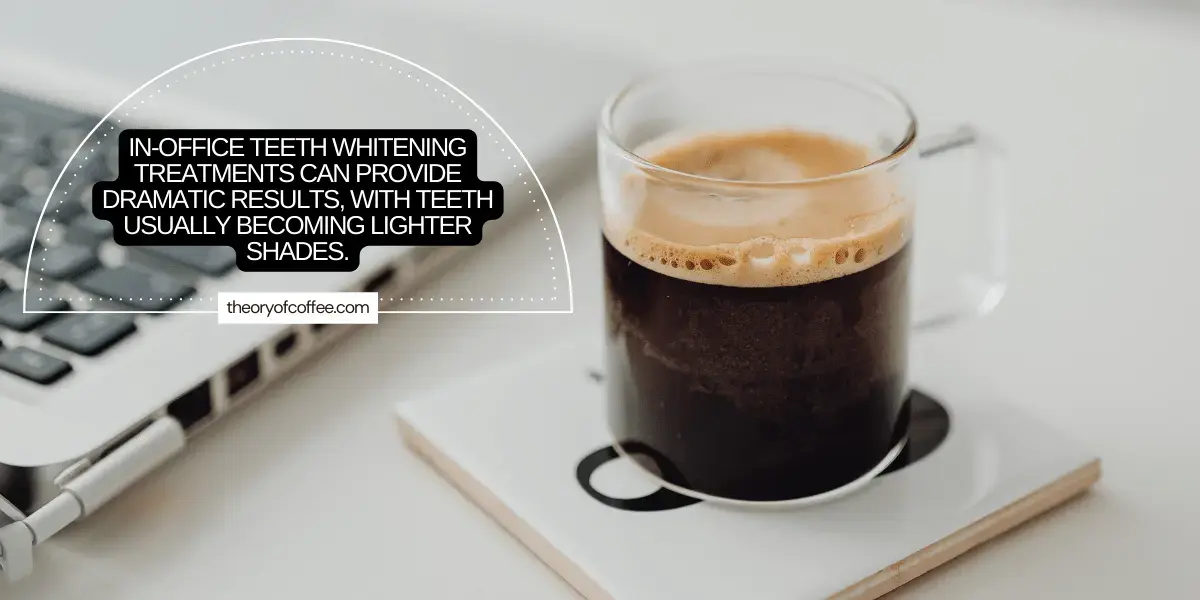
Professional teeth whitening treatments may be your best bet if you seek faster and more noticeable results in removing coffee stains from your teeth. Dental professionals perform these treatments and offer more robust and targeted whitening solutions. Here are some common professional teeth whitening options to consider:
5.1. In-Office Teeth Whitening
In-office teeth whitening, also known as chairside whitening or power bleaching, is a popular option for achieving immediate and significant results. The procedure is performed by a dental professional and typically involves the following steps:
- Your dentist will examine your teeth and discuss your desired level of whitening.
- A protective barrier or gel will be applied to your gums to minimize sensitivity.
- The dentist will apply a bleaching gel containing hydrogen peroxide to your teeth.
- A special light or laser may activate the bleaching gel and enhance its effectiveness.
- The gel will be left on your teeth for a specified time, usually in multiple sessions.
- After the treatment, the gel will be rinsed off, and your teeth will be evaluated to determine the level of whitening achieved.
In-office teeth whitening treatments can provide dramatic results, with teeth usually becoming lighter shades. However, it’s important to note that the cost of these treatments can vary depending on the severity of the stains and the number of sessions required.
5.2. Take-Home Teeth Whitening Kits
Take-home teeth whitening kits provide a more convenient and cost-effective option for teeth whitening. These kits typically include custom-fitted trays and a whitening gel containing a lower concentration of hydrogen peroxide than in-office treatments. Here’s how take-home teeth whitening kits work:
- Your dentist will take impressions of your teeth to create custom-fitted trays.
- You’ll be provided with the trays and a whitening gel to use at home.
- Following your dentist’s instructions, you’ll fill the trays with the gel and wear them for a specified amount each day.
- Over several weeks, the gel will gradually whiten your teeth, removing coffee stains and restoring their natural whiteness.
Take-home teeth whitening kits may take longer to achieve noticeable results than in-office treatments. However, they offer the convenience of whitening teeth in the comfort of your home at a more affordable price.
5.3. Combination Treatments
In some cases, a combination of in-office and take-home treatments may be recommended to achieve the desired level of whitening. For example, your dentist may perform an in-office treatment to kick-start the whitening process and provide you with a take-home kit for ongoing maintenance and touch-ups.
It’s essential to consult with a dental professional to determine the most suitable teeth whitening option for your specific needs. They can assess the severity of your coffee stains, discuss your goals, and recommend the best course of treatment to achieve the desired results.
6. Maintaining Your White Smile Post-Stain Removal
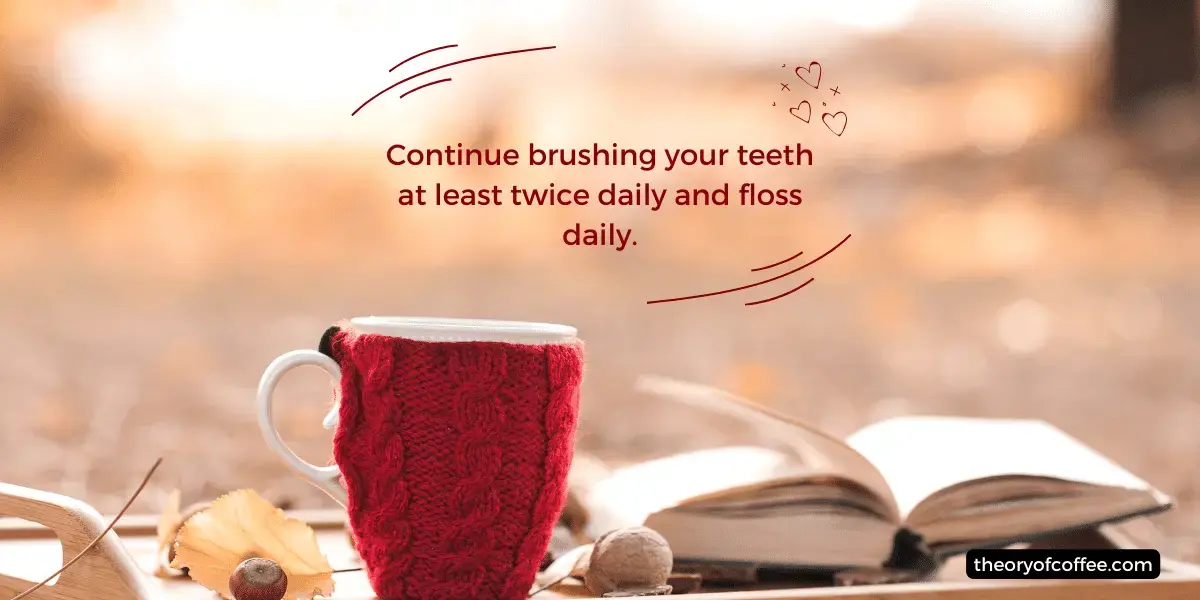
Congratulations! You have successfully removed those stubborn coffee stains from your teeth. It’s essential to maintain your newly brightened smile and prevent future staining. Here are some tips to help you maintain a white smile after coffee stain removal:
- Practice Good Oral Hygiene: Continue brushing your teeth at least twice daily and floss daily. Good oral hygiene is crucial for preventing plaque buildup and minimizing the risk of future staining.
- Choose Whitening Toothpaste: Make whitening part of your daily oral care routine. Whitening toothpaste contains ingredients that can help remove surface stains and maintain the whiteness of your teeth.
- Avoid Staining Foods and Drinks: Limit your consumption of foods and drinks that cause staining, such as coffee, tea, red wine, soda, and berries. If you indulge in these beverages, consider using a straw to minimize their contact with your teeth.
- Maintain a Healthy Diet: A diet rich in fruits and vegetables can help maintain the whiteness of your teeth. Crunchy fruits and vegetables like apples and carrots can act as natural toothbrushes, gently scrubbing surface stains.
- Attend Regular Dental Check-Ups: Regular dental check-ups are essential for maintaining a white smile. Your dentist can monitor the health of your teeth, provide professional cleanings, and address any concerns or potential issues before they worsen.
Following these tips, you can enjoy a bright white smile after removing those coffee stains. Remember, consistency in your oral care routine and lifestyle choices plays a significant role in maintaining the whiteness of your teeth.
7. FAQs

Q: How can I prevent coffee stains from forming on my teeth?
A: Proper oral hygiene is crucial in preventing coffee stains on your teeth. It is recommended to brush your teeth thoroughly twice a day, floss daily, and rinse your mouth with water after consuming coffee. By incorporating these habits into your daily routine, you can ensure a healthy and stain-free smile. Additionally, using a straw to drink coffee, choosing whitening toothpaste, and attending regular dental check-ups can help prevent coffee stains.
Q: Are store-bought whitening kits effective for removing coffee stains?
A: Store-bought whitening kits can effectively remove coffee stains, but the results may vary. It’s essential to follow the instructions carefully and consult a dental professional to ensure you use the right product.
Q: How often should I use baking soda to whiten my teeth?
A: Baking soda can be used once or twice weekly to whiten teeth. However, it must be used in moderation to prevent enamel erosion. If you experience tooth sensitivity or irritation, discontinue use and consult a dental professional.
Note: It is important to note that the following FAQs are intended solely for informational purposes and not to replace professional dental advice. We highly recommend consulting with a dental professional if you have any concerns or questions about your dental health.
8. Conclusion
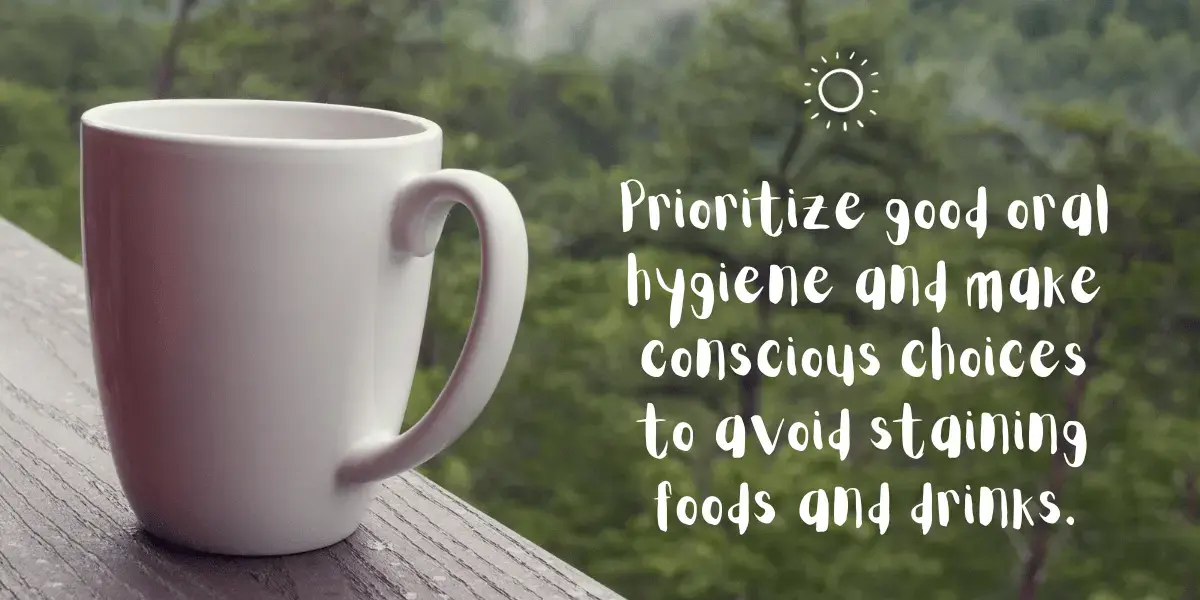
In conclusion, coffee stains on teeth can be a common concern for coffee lovers. However, with the proper knowledge and tools, you can remove and prevent these stains, allowing you to enjoy your favorite beverage without sacrificing your bright smile. Whether you opt for over-the-counter solutions, natural remedies, or professional teeth whitening treatments, it’s crucial to prioritize good oral hygiene and make conscious choices to avoid staining foods and drinks. Remember, maintaining a healthy white smile is a lifelong commitment requiring consistent effort and regular dental care.